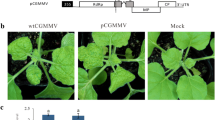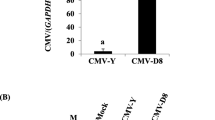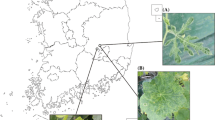Abstract
Cucumber green mottle mosaic virus (CGMMV), a tobamovirus, infects cucurbitaceous plants including watermelon. An attenuated strain of CGMMV (CGMMV-SH33b) has been isolated from CGMMV-SH and used for protecting muskmelon against wild CGMMV. There are five of nine base changes that lead to amino acid substitutions in the genome between SH and SH33b: four in replicase and one in coat protein. Using cDNA clones of both strains, two recombinant clones were constructed: first clone (pCG-KK) has two base changes (one silent at nt 5089 and the other P1397S amino acid substitution in the read-through part of SH 186K replicase) and the second clone (pCG-SP) has two silent base changes and three base changes in SH 129K/186K replicase (A1124V, N1157D and P1397S). The symptom severity on Nicotiana benthamiana induced by each recombinant virus were intermediate between those by SH and by SH33b. The accumulation levels of viruses using ELISA in infected plants were coinciding with symptom severity. Northern blot analysis of Nicotiana benthamiana at 10 dpi indicated that the virus accumulations of these recombinants was in the order of SH>pCG-KK>pCG-SP>SH33b. These results suggest that base changes located in the read-through part of 186K replicase as well as other base changes are responsible for the virus attenuation although we cannot excluded the possibility of silent mutations involved in pathogenicity. Using green fluorescent protein gene (GFP) silenced transgenic tobacco; infection with CGMMV-SH significantly suppressed GFP silencing with visible symptoms, whereas CGMMV-SH33b and their chimera viruses resulted in partial suppression. The suppression was further supported by lower level of GFP mRNA and higher siRNA detected in SH33b infected leaves, than those in CGMMV-SH infections, suggesting that the levels of virus accumulation and symptom severity on N. benthamiana were reasonably parallel with the suppression of RNA silencing of GFP mRNA.





Similar content being viewed by others
Abbreviations
- CGMMV:
-
Cucumber green mottle mosaic virus
- GFP:
-
Green fluorescent protein gene
- siRNA:
-
Small interfering RNA
- RISC:
-
RNA-Induced silencing complex
- dsRNA:
-
Double-stranded RNA
- SH:
-
Severe strain
References
Ali ME, Kobayashi K, Yamaoka N, Ishikawa M, Nishiguchi M (2013) Graft transmission of RNA Silencing to non-transgenic scions for conferring virus resistance in tobacco. PLoS One 8(5):e63257
Anonymous (1988) Control of melon mosaic disease by attenuated virus. Shizuoka Prefect Agric Fish Dep Rep. No. 1765, Shizuoka Pref. Gov. Shizuoka, 1–12
Choi GS (2001) Occurrence of two Tobamovirus diseases on cucurbits and control measures in Korea. Plant Pathol J 17:243–248
Clark MF, Adams AN (1977) Characteristics of the microplate method of enzyme-linked immunosorbent assay for the detection of plant viruses. J Gen Virol 34(475):483
Csorba T, Bovi A, Dalmay T, Burgyán J (2007) The p122 subunit of Tobacco mosaic virus replicase is a potent silencing suppressor and compromises both small interfering RNA- and microRNA mediated pathways. J Virol 81:11768–11780
Fuchs M (2008) Plant resistance to viruses: engineered resistance. In: Mahy Brian WJ (ed) Desk encyclopedia of plant and fungal virology. Academic, New York, pp 44–52
Fulton RW (1986) Practices and precautions in the use of cross protection for plant virus disease control. Annu Rev Phytopathol 24:67–81
Hagiwara K, Ichiki TU, Ogawa Y, Omura T, Tsuda S (2002) A single amino acid substitution in 126-kDa protein of Pepper mild mottle virus associates with symptom attenuation in pepper; the complete nucleotide sequence of an attenuated strain, C 1421. Arch Virol 147:833–840
Hagiwara-Komoda Y, Hirai K, Mochizuki A, Nishiguchi M, Meshi T, Ishikawa M (2008) Overexpression of a host factor TOM1 inhibits tomato mosaic virus propagation and suppression of RNA silencing. Virology 376:132–139
Haque AKMN, Tanaka Y, Nishiguchi M (2007) Analysis of transitive RNA silencing after grafting in transgenic plants with the coat protein gene of Sweet potato feathery mottle virus. Plant Mol Biol 63:35–47
Hull R (2002) Matthews plant virology. Academic, New York
Ichiki TU, Nagaoka EN, Hagiwara K (2005) Integration of mutations responsible for the attenuated phenotype of Pepper mild mottle virus strains results in a symptomless cross-protecting strain. Arch Virol 150(10):2009–2020
Kubota K, Tsuda S, Tamai A, Meshi T (2003) Tomato mosaic virus replication protein suppresses virus-targeted posttranscriptional gene silencing. J Virol 77:11016–11026
Lee KY, Lee BC, Park HC (1990) Occurrence of Cucumber green mottle mosaic virus disease of watermelon in Korea. Korean J Phytopathol 6:250–255
Miki D, Shimamoto K (2004) Simple RNAi vectors for stable and transient suppression of gene function in rice. Plant Cell Physiol 45:490–495
Motoyoshi F, Nishiguchi M (1988) Control of virus by attenuated virus strains. Comparison between attenuated strain of cucumber green mottle mosaic virus and tobacco mosaic virus. Gamma Field Symp Inst Radiat Breed Natl Inst Agrobiol Resour 27:91–109
Murakami Y, Samuel L, Ugaki M, Nishizawa Y, Mochizuki A, Sonoda S, Nishiguchi M (1999) In vitro synthesis of infectious RNA from cDNA of Cucumber green mottle mosaic tobamovirus (CGMMV-SH) and the production of its movement protein mutants. Ann Phytopathol Soc Jpn 65(3):331 (in Japanese)
Nagai Y (1984) Utilization of attenuated strain of tobacco mosaic virus for control of tomato mosaic disease. Crop Prot 38:345–348 (in Japanese)
Nishiguchi M, Kobayashi K (2011) Attenuated plant viruses: preventing virus diseases and understanding the molecular mechanism. J Gen Plant Pathol 77:221–229
Nishigushi M, Kikuchi S, Kiho Y, Ohno T, Meshi T, Okada Y (1985) Molecular basis of plant viral virulence: the complete nucleotide sequence of an attenuated strain of tobacco mosaic virus. Nucl Acids Res 13(5):5585–5590
Nishikiori M, Dohi K, Mori M, Meshi T, Naito S, Ishikawa M (2006) Membrane-bound Tomato mosaic virus replication proteins participate in RNA synthesis and are associated with host proteins in a pattern distinct from those that are not membrane bound. J Virol 80:8459–8468
Oshima N (1981) Control of tomato mosaic disease by attenuated virus. Jpn Agric Res Q 14:222–228
Rast ATB (1972) M II-16, an artificial symptomless mutant of tobacco mosaic virus for seedling inoculation of tomato crops. Neth J Plant Pathol 78:110–112
Shimono M, Ino M, Sonoda S, Fujimura T, Nishiguchi M (2005) Inverse correlation between mRNA levels in GFP-silenced transgenic Nicotiana benthamiana and resistance to Potato virus X engineered to contain GFP sequence. J Gen Plant Pathol 71(2):147–152
Tan SH, Nishiguchi M, Sakamoto W, Ogura Y, Murata M, Ugaki M, Tomiyama M, Motoyoshi F (1997) Molecular analysis of the genome of an attenuated strain of Cucumber green mottle mosaic virus. Ann Phytopathol Soc Jpn 63:470–474
Tsuda S, Kubota K, Kanda A, Ohki T, Meshi T (2007) Pathogenicity of Pepper mild mottle virus is controlled by the RNA silencing suppression activity of its replication protein but not the viral accumulation. Phytopathology 97:412–420
Ugaki M, Tomiyama M, Kakutani T, Hidaka S, Kiguchi T, Nagata R, Sato T, Motoyoshi F, Nishiguchi M (1991) The complete nucleotide sequence of Cucumber green mottle mosaic virus (SH strain) genomic RNA. J Gen Virol 72:1487–1495
Yang G, Qiu BS, Liu XG, Li Y, Wang XF (2002) Nonsense mutations of replicase and movement protein genes contribute to the attenuation of an avirulent tomato mosaic virus. Virus Res 87(2):119–128
Acknowledgments
We are grateful to M. Nogami and K. Kohara for the plasmids of cDNA cloning. We also thank D. Murphy for checking the English in this manuscript. This work was supported by the Program for Promotion of Basic and Applied Researches in Bio-oriented Industry (BRAIN), the Ministry of Education, Culture, Sports and Technology of Japan [Grant-in-Aid for Scientific Research for Scientific Research (C), No. 24580065 to MN] and the Japan Science and Technology Agency for the A-step (Adaptable & Seamless Technology Transfer Program through Target-driven R & D) to MN.
Author information
Authors and Affiliations
Corresponding author
Rights and permissions
About this article
Cite this article
Ali, M.E., Waliullah, S. & Nishiguchi, M. Molecular analysis of an attenuated strain of Cucumber green mottle mosaic virus using in vitro infectious cDNA clone: pathogenicity and suppression of RNA silencing. J. Plant Biochem. Biotechnol. 25, 79–86 (2016). https://doi.org/10.1007/s13562-015-0312-z
Received:
Accepted:
Published:
Issue Date:
DOI: https://doi.org/10.1007/s13562-015-0312-z




